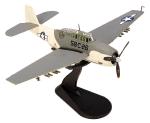Hobby Master Archive
Air Power Propellers 1/72
TBF/TBM
On the afternoon of December 7, 1941, Grumman opened a new manufacturing plant and held a ceremony to show off the new TBF to the public. Ironically this is the same “Day that will live in infamy” when the Imperial Japanese Navy attacked Pearl Harbor. After the ceremony, the plant was quickly sealed off to prevent any possible enemy action. Grumman’s first torpedo bomber was the heaviest single-engine plane of WWII, and it was the first to feature a new Grumman designed folding wing mechanism that would greatly increase storage space on an aircraft carrier. Another Grumman aircraft to utilize this folding wing was the F6F Hellcat. There were three crew members–pilot, turret gunner, and radioman/bombardier/ventral gunner. Equipped with a .50-caliber machine gun in each wing, one .50 caliber gun mounted right next to the turret gunner’s head in a rear-facing electrically-powered turret. A single .30 caliber hand-fired machine gun mounted under the tail was available to defend against enemy fighters attacking from a below and to the rear. This gun was fired by the radioman/bombardier while standing up and bending over in the belly of the tail section but he usually sat on a folding bench facing forward to operate the radio and to sight in bombing runs. Equipped with a large bomb bay the Avenger could hold a torpedo, a single 2000 lb bomb, or up to four 500 lb bombs. By 1944, it was rare for American aircraft to encounter enemy shipping so the Avenger was used mostly as a ground support weapon. The most notable features of the Avenger was its ruggedness and ease of handling best described by the pilots as flying a truck. Along with the normal role of torpedoing surface vessels Avengers sent some thirty submarines to the bottom. One such sub was the cargo submarine I-52 whose wreck was located in 1998. Recognized as one of the most effective sub killers in the Pacific the Avenger was put to work in the Atlantic protecting convoys from U-boats once Escort Carriers were made available. The Avenger was also used by the Royal Navy’s Fleet Air Arm where it was first known as the “Tarpon” but eventually was referred to as the Avenger. The first 402 aircraft were known as Avenger Mk 1, 334 TBM-1s were the Avenger Mk II and 334 TBM-3 as Mark III. Post war the antisubmarine version was the “Avenger AS Mk IV” in RN service. One other military used the Avenger in WWII, the Royal New Zealand Air Force operating from South Pacific islands as bombers.
Designed as a replacement for the aging TBD-1 Devastator the new TBF-1 was hastily sent to Midway when the USN became aware of the imminent attack on the island. The six TBF-1s were sent to attack the Japanese fleet that resulted in 5 aircraft being shot down and the 6th crash-landed on Midway. Lesson learned more firepower was added by placing a .50 caliber machine gun in each wing and larger fuel tanks. This modification brought about the TBF-1C with later modifications adding four rockets rails under each wing.



















